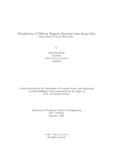| dc.contributor.advisor | Alam, Dr. Md. Ashraful | |
| dc.contributor.author | Ibn Hasib, Fahad | |
| dc.contributor.author | Swarna, Nakiba Farhana | |
| dc.date.accessioned | 2023-07-11T09:17:59Z | |
| dc.date.available | 2023-07-11T09:17:59Z | |
| dc.date.copyright | 2021 | |
| dc.date.issued | 2021-09 | |
| dc.identifier.other | ID: 21141002 | |
| dc.identifier.other | ID: 21341054 | |
| dc.identifier.uri | http://hdl.handle.net/10361/18737 | |
| dc.description | This thesis is submitted in partial fulfillment of the requirements for the degree of Bachelor of Science in Computer Science, 2021. | en_US |
| dc.description | Cataloged from PDF version of thesis. | |
| dc.description | Includes bibliographical references (pages 37-39). | |
| dc.description.abstract | We apply machine learning, specially deep neural network approaches, to train
a new model that can perform an effective classification of ferromagnetic, anti ferromagnetic, skyrmion, anti-skyrmion and spin spiral configurations via supervised
learning and also observe how the pre trained models like VGG16, VGG19, ResNet,
Inception behave while solving this problem, draw a pattern from it and suggest
path for further improving the model. The problem relies in categorization of Mag netic Configurations amongst many from input samples of simulation data in order
to retrieve classified outcome from several different magnetic configurations. The
data for the input sample derives from simulations of physical properties of various
magnetic configurations. First CNN is used to classify between the images. Image
classifications are mostly carried out using neural networks where data is placed in a
graphical structure. In addition, the SVM method is applied twice, once with PCA
and once without PCA. The proposed model in this research paper can success fully classify amongst magnetic configurations in real time with data obtained from
spin-polarized scanning tunneling and Lorentz transmission electron microscopy. In
our approach, we used a single deep neural network architecture is classify all five
types of magnetic structures. All in all, this is a holistic approach for solving the
classification problem of magnetic configuration and taking a step into optimizing
the model. | en_US |
| dc.description.statementofresponsibility | Fahad Ibn Hasib | |
| dc.description.statementofresponsibility | Nakiba Farhana Swarna | |
| dc.format.extent | 39 pages | |
| dc.language.iso | en | en_US |
| dc.publisher | Brac University | en_US |
| dc.rights | Brac University theses are protected by copyright. They may be viewed from this source for any purpose, but reproduction or distribution in any format is prohibited without written permission. | |
| dc.subject | Deep Neural Network | en_US |
| dc.subject | Magnetic structure | en_US |
| dc.subject | Image classification | en_US |
| dc.subject | Machine learning | en_US |
| dc.subject | Res-Net | en_US |
| dc.subject.lcsh | Neural networks (Computer science) | |
| dc.title | Classification of different magnetic structures from image data using deep neural networks | en_US |
| dc.type | Thesis | en_US |
| dc.contributor.department | Department of Computer Science and Engineering, Brac University | |
| dc.description.degree | B. Computer Science | |

